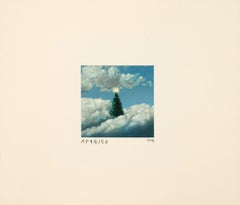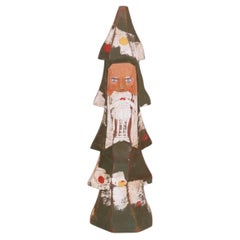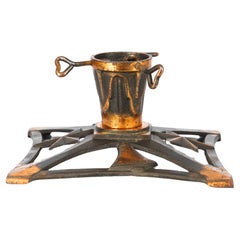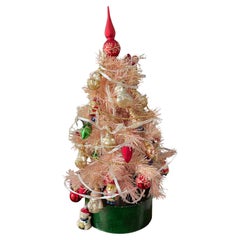Vintage Christmas Tree
to
70
415
226
647
338
193
121
58
52
41
41
41
30
52
20
17
11
7
Sort By
Christmas Tree
By James Bidgood
Located in New York, NY
Christmas Tree
c. 1966/2022
Signed, dated, and numbered, verso
Digital C-print
31 x 31 inches
Category
1960s Contemporary Vintage Christmas Tree
Materials
C Print
Christmas Tree
By Fanny Brennan
Located in Greenwich, CT
Christmas Tree is a lithograph on paper with an image size of 2.25 x 2.25 inches, initialed 'FMB
Category
20th Century Surrealist Vintage Christmas Tree
Materials
Paper, Lithograph
German Christmas Tree Santa
Located in Bradenton, FL
A German folk art Christmas tree Santa. Made of wood and carved in a simplistic fir tree shape
Category
Mid-20th Century Vintage Christmas Tree
Materials
Wood
Vintage Christmas tree stand, 1970s.
Located in Praha, CZ
Green metal Christmas tree stand.
The stand can be unfolded (see photo)
With aging patina
Category
1970s Czech Mid-Century Modern Vintage Christmas Tree
Materials
Metal
Iron christmas tree holder around 1950s
Located in Wien, AT
Iron christmas tree holder around 1950s
Iron lacquered
Category
1950s Austrian Mid-Century Modern Vintage Christmas Tree
Materials
Iron
Miriam Haskell Rare Holiday Christmas Tree Brooch
By Miriam Haskell
Located in New York, NY
Miriam Haskell's rare Holiday Christmas Tree Brooch. The naturalistic form Christmas Tree is hand
Category
1950s American Vintage Christmas Tree
Materials
Gold Plate, Brass, Gilt Metal
Christmas Tree In The Snow. Oil on Board.
Located in Cotignac, FR
An oil on panel view of a Christmas tree in a landscape heavy with snow by Boggio. The painting is
Category
Mid-20th Century Romantic Vintage Christmas Tree
Materials
Oil, Board
15” Pink Christmas Trees w Miniature German Ornaments
Located in Boca Raton, FL
Cute small 15” pink Christmas trees decorated with miniature blown glass European Christmas
Category
1970s Vintage Christmas Tree
Materials
Blown Glass, Acrylic
Pair Miniature Christmas Trees on Gold Tray
Located in Boca Raton, FL
Cute pair of miniature bottlebrush Christmas trees on an Italian gold leaf wood tray, with two
Category
1970s American American Craftsman Vintage Christmas Tree
Materials
Wood
Mercury Glass Santa Holding Tree Christmas Tree Ornament
Located in Clifton Forge, VA
miniature Christmas Tree. He is bright shiny red on his coat and hat but the red darkens due to age
Category
20th Century Unknown Folk Art Vintage Christmas Tree
Materials
Mercury Glass
$96 Sale Price
20% Off
H 2.75 in W 1.5 in D 1.25 in
Japanese Christmas Tree - Woodcut Print - Mid-20th Century
Located in Roma, IT
Japanese Christmas Tree is an original modern artwork realized by a Japanese artist in the mid-20th
Category
Mid-20th Century Modern Vintage Christmas Tree
Materials
Woodcut
$357
H 7.09 in W 5.52 in D 0.04 in
Christmas Tree Stand Iron Folk Art German
Located in Kitzbühel, Tirol
Hugh Christmas tree stand made of iron. The stand is decorated with three large hands painted Santa
Category
Mid-20th Century German Folk Art Vintage Christmas Tree
Materials
Iron
Mercury Glass Nutcracker Toy Soldier Christmas Tree Ornament
Located in Clifton Forge, VA
This is the cutest Nutcracker Soldier Christmas Tree ornament made of blown molded glass. He has a
Category
20th Century Unknown Folk Art Vintage Christmas Tree
Materials
Mercury Glass
$96 Sale Price
56% Off
H 4 in W 1.5 in D 1 in
Vintage Glass Christmas Tree Top, Czechoslovakia, 1950's.
Located in Praha, CZ
A beautiful glass ornament for the Christmas tree, it has a stepped structure with a soft pink
Category
1950s Czech Mid-Century Modern Vintage Christmas Tree
Materials
Glass
Vintage German Christmas Tree Stand Iron Folk Art .
Located in Kitzbühel, Tirol
Hugh Christmas tree stand made of iron. The stand is decorated with three large hands painted Santa
Category
Mid-20th Century German Folk Art Vintage Christmas Tree
Materials
Iron
B.A. Ballou Sterling Silver Christmas Tree Pin Brooch #20497
Located in Washington Depot, CT
B.A. Ballou Sterling Silver Christmas Tree Pin Brooch -
This vintage Christmas tree pin brooch is
Category
20th Century Vintage Christmas Tree
Materials
Sterling Silver
Green Handcrafted Cast Iron Art Deco Stand for Christmas Tree, Europe, 1960s
Located in 05-080 Hornowek, PL
This early 20th century, cast iron Christmas tree stand is especially crafted for small Christmas
Category
Mid-20th Century French Art Deco Vintage Christmas Tree
Materials
Iron
$297
H 5.52 in W 9.85 in D 9.85 in
Christmas Tree and Horses - Lithograph, Ltd 100 copies
Located in Paris, IDF
Jean Marais (1913 - 1998)
Christmas Tree and Horses
Original lithograph
Signed with the stamp of
Category
Late 20th Century Modern Vintage Christmas Tree
Materials
Lithograph
Spode Stoneware Christmas Tree Meat Platter On Stand
By Copeland Spode
Located in Bridgeport, CT
A shaped oval meat platter with well in the classic Spode Christmas Tree pattern. Displayed in a
Category
Late 20th Century English Victorian Vintage Christmas Tree
Materials
Ceramic, Wood
Golden Christmas Tree, Georg Jensen Christmas Ornament 1986, Sven Vestergaard
By Georg Jensen
Located in Brønshøj, DK
the middle of a Christmas tree.
The artist Sven Vestergaard, who has been the head of the royal
Category
1980s Danish Vintage Christmas Tree
Materials
Brass
$238
H 4.38 in W 3.12 in D 0.6 in
December : Christmas Tree - Original handsigned etching - Exceptional n° 1/100
By Albert Decaris
Located in Paris, IDF
Albert DECARIS
December : Christmas Tree
Original etching
Signed in pencil
Exceptional copy
Category
Mid-20th Century Photorealist Vintage Christmas Tree
Materials
Etching
$417
H 25.99 in W 19.69 in
Exceptional Vintage Antique Mercury Glass Christmas Tree Topper German, 1930s
Located in Nuernberg, DE
A rare large feather tree glass Christmas tree topper. It is made from mouth blown glass, would be
Category
1930s German Folk Art Vintage Christmas Tree
Materials
Glass
Cute Miniature Christmas Tree with Lights in Globe by Bridget Mcguartney
Located in Boca Raton, FL
Vintage handcrafted cute miniature Christmas Tree in a glass globe. Decorated with handmade silk
Category
1970s American Country Vintage Christmas Tree
Materials
Textile, Glass, Plastic, Wood
Vintage Eisenberg Designer Signed Faux Gemstone Christmas Tree Brooch Pin
By Eisenberg
Located in Montreal, QC
Simply Beautiful! Vintage Designer Signed Eisenberg Classic Christmas Tree with Faux Multi
Category
Late 20th Century American Modernist Vintage Christmas Tree
Materials
Crystal, Gold Plate
Midcentury Anzengruber Ceramic Christmas Tree with Silent Night Playpiece
By Leopold Anzengruber
Located in Vienna, AT
This Amazing and rara Austrian Midcentury Christmas tree was designed by Leopold Anzengruber 1948
Category
1950s Austrian Mid-Century Modern Vintage Christmas Tree
Materials
Ceramic
Goebel Set of Seven Vintage Annual Angel Bells Christmas Tree Ornaments
By Goebel Company
Located in Bochum, NRW
Goebel Set of Seven Vintage Annual Angel Bells Christmas Tree Ornaments,
Germany 1980s - 1990s
Category
Mid-20th Century German Vintage Christmas Tree
Materials
Porcelain
$834 / set
H 3.94 in W 3.15 in D 2.37 in
West Germany Mercury Glass Large 4.5" Santa Head Christmas Tree Ornament
Located in Clifton Forge, VA
What a great large mercury glass Santa head Christmas tree ornament. The beard, mustache, hat band
Category
Mid-20th Century German Folk Art Vintage Christmas Tree
Materials
Mercury Glass
$128 Sale Price
32% Off
H 4.5 in W 2.5 in D 2 in
CHRISTMAS TREE Signed Mini Lithograph, Evergreen, Shining Star, Clouds, Blue Sky
By Fanny Brennan
Located in Union City, NJ
CHRISTMAS TREE is a hand drawn limited edition lithograph by the American surrealist artist Fanny
Category
1990s Surrealist Vintage Christmas Tree
Materials
Lithograph
$264 Sale Price
38% Off
H 6 in W 7 in
14k Yellow Gold 1960s Mid Century Merry Christmas Tree Pendant w/ Ruby & Emerald
Located in Lexington, KY
This is a cheerful Christmas tree pendant from the 1960s, made in 14k yellow gold with ruby and
Category
1960s Modern Vintage Christmas Tree
Materials
Emerald, Ruby, Gold, 14k Gold, Yellow Gold
Mid Century Silver & Green Aluminum Christmas Tree, "Starlite" by Revlis
By Alcoa Aluminum
Located in Buffalo, NY
Seldom seen Mid Century Modern silver & green over 7' Aluminum christmas tree."STARLITE" by Revlis
Category
1960s American Mid-Century Modern Vintage Christmas Tree
Materials
Aluminum
Set of Five Christmas Tree Ornaments Red and White Glass Mushrooms, 1970s
Located in Barntrup, DE
Set of five Christmas tree ornaments red and white glass mushrooms, Germany, circa the 1970s
Category
1970s German Mid-Century Modern Vintage Christmas Tree
Materials
Glass
$446 / set
H 3.94 in Dm 1.58 in
West Germany Mercury Glass Santa in Fireplace Large 5" Christmas Tree Ornament
Located in Clifton Forge, VA
Such a cute and hard to find large Christmas Tree ornament with the embossed image of Santa with
Category
Mid-20th Century German Folk Art Vintage Christmas Tree
Materials
Mercury Glass
$136 Sale Price
39% Off
H 5 in W 2.5 in D 2 in
Italian Murano Green Glass Wrapped Candy Christmas Tree Ornament
Located in Clifton Forge, VA
us know if we can answer any questions. We have other Christmas Tree ornaments listed and offer free
Category
20th Century Italian Mid-Century Modern Vintage Christmas Tree
Materials
Murano Glass
$128 Sale Price
20% Off
H 1.5 in W 3.5 in D 1.5 in
West Germany Blown Glass Flattened Ball White Christmas Tree Ornament
Located in Clifton Forge, VA
This is a great simple hand blown solid white Christmas tree ornament that would make a wonderful
Category
Mid-20th Century German Mid-Century Modern Vintage Christmas Tree
Materials
Blown Glass
$72 Sale Price
20% Off
H 3 in W 2.75 in D 0.5 in
Mercury Glass Santa Holding Charlie Brown Tree Christmas Tree Ornament
Located in Clifton Forge, VA
I have two of these sweet Santa holding a Charlie Brown Christmas Tree ornaments available but have
Category
20th Century Unknown Folk Art Vintage Christmas Tree
Materials
Mercury Glass
$72 Sale Price / item
20% Off
H 3.25 in W 1.5 in D 1.5 in
English Victorian Style Spode Christmas Tree Wine / Water Glass Goblets - S/8
By Spode
Located in Kennesaw, GA
This is an offering of Victorian style Spode Christmas Tree water or wine goblets. They date to the
Category
Late 20th Century English Victorian Vintage Christmas Tree
Materials
Gold
$295 / set
H 7 in Dm 3 in
Christmas Tree Love, Original holiday cover for The Saturday Evening Post
By Constantin Alajalov
Located in Fort Washington, PA
carrying a Christmas tree only to discover that his wife has already bought one. The woman, who is standing
Category
1950s Vintage Christmas Tree
Materials
Gouache, Board
$80,000
H 19.25 in W 14.5 in
Large Bulbous Gold & White Christmas Tree Tree Hand Blown Ornament Decoration
Located in Clifton Forge, VA
decoration for your Christmas tree, or other winter or holiday display. It has some darkening on the creases
Category
Mid-20th Century Unknown Mid-Century Modern Vintage Christmas Tree
Materials
Blown Glass
$120 Sale Price
20% Off
H 4 in W 2.25 in D 2.25 in
West Germany Mercury Glass Santa Head Christmas Tree Ornament
Located in Clifton Forge, VA
The Moody Carpenter and please feel free to ask questions. We have other Christmas Tree ornaments
Category
Mid-20th Century German Folk Art Vintage Christmas Tree
Materials
Mercury Glass
$88 Sale Price / item
20% Off
H 3.25 in W 2 in D 2 in
Christmas Tree, Original Holiday Greeting Card Illustration
By Charlotte Sternberg
Located in Fort Washington, PA
Original holiday greeting card Illustration of a Christmas tree decorated with ornaments and bows
Category
1960s Vintage Christmas Tree
Materials
Gesso, Egg Tempera, Panel
$3,000
H 16 in W 20 in
Christmas Swim - Christmas Tree in Swimming Pool with Tinsel and Star
By Slim Aarons
Located in Brighton, GB
Christmas Swim - Christmas Tree in Swimming Pool with Tinsel and Star by Slim Aarons features Slim
Category
20th Century American Modern Vintage Christmas Tree
Materials
C Print, Photographic Paper, Color, Digital
$3,781
H 16 in W 20 in D 0.1 in
Christmas Traffic - American Christmas Tree Traffic at Night with Car Lights
By Slim Aarons
Located in Brighton, GB
Christmas Traffic - American Christmas Tree Traffic at Night with Car Lights by Slim Aarons
16 x
Category
20th Century American Modern Vintage Christmas Tree
Materials
C Print, Digital, Photographic Paper, Color
$3,781
H 16 in W 16 in D 0.1 in
Gold & Orange Blown Mercury Glass Circus Lion Christmas Tree Ornament
Located in Clifton Forge, VA
Christmas Tree ornaments but would be wonderful in other decorative ways or occasions.
I have other
Category
Late 20th Century Unknown Folk Art Vintage Christmas Tree
Materials
Blown Glass
$40 Sale Price / item
20% Off
H 3.5 in W 2 in D 1.5 in
Vintage Green Enamel Christmas Tree Brooch with Rhinestone Ornaments in Gold
Located in Milford, DE
A stylized Christmas tree design, crafted in green enamel and adorned with seven bezel-set
Category
20th Century American Retro Vintage Christmas Tree
Materials
Crystal
Vintage Dominique Huge Jewelled Christmas Tree Brooch 1980s
Located in Wilmslow, GB
A spectacular and large Vintage Dominique Christmas Tree Brooch with dangling baubles and candles
Category
1980s Vintage Christmas Tree
Vintage Dominique Large Jewelled Christmas Tree Brooch 1980s
Located in Wilmslow, GB
A spectacular and large Vintage Dominique Christmas Tree Brooch with dangling baubles and candles
Category
1980s Vintage Christmas Tree
Cartier Christmas Tree Design Card and Envelope Set Luxury Season's Greetings
By Cartier
Located in North Hollywood, CA
Cartier Card and Envelope Set with the Iconic Christmas Tree Design.
Cartier Season's Greetings
Category
Late 20th Century French Art Deco Vintage Christmas Tree
Materials
Paper
$29 / item
H 5.25 in W 7.5 in D 0.05 in
Vintage Dominique Large Jewelled Christmas Tree Brooch 1980s
Located in Wilmslow, GB
A spectacular and large Vintage Dominique Christmas Tree Brooch with dangling baubles and candles
Category
1980s Vintage Christmas Tree
Orange Blown Glass Hand Painted Church Flattened Ball Christmas Tree Ornament
Located in Clifton Forge, VA
Absolutely adorable hand blown orange glass flattened ball Christmas tree ornament with a church
Category
Mid-20th Century Unknown Folk Art Vintage Christmas Tree
Materials
Blown Glass, Paint
$120 Sale Price
20% Off
H 3.25 in W 2.75 in D 0.75 in
Alexandre Hogue Original Lithograph, 1941 - Oil Field Christmas Tree
By Alexandre Hogue
Located in Phoenix, AZ
Original lithograph by Texas artist Alexandre Hogue (1898-1994).
Title: Oil Field Christmas Tree
Category
Mid-20th Century Vintage Christmas Tree
Materials
Paper, Ink
$4,500
H 22.5 in W 17 in D 2 in
Christmas Tree in Village Square
By Conrad Dickel
Located in Fort Washington, PA
Advertisement for the Interwoven Stocking Company, New Brunswick, NJ.
Category
1940s Vintage Christmas Tree
Materials
Gouache
"Lanvin Paris Lady Christmas Tree"
By Alexander Warren Montel
Located in Bristol, CT
Art Sz: 23"H x 14 1/2"W
Category
1950s Vintage Christmas Tree
Materials
Paper, Watercolor
Vintage Aurora Borealis Icy White & Blue Rhinestone Christmas Tree Brooch, Gold
Located in Milford, DE
This dazzling vintage Christmas tree brooch features a modern, geometric silhouette, crafted with
Category
20th Century American Retro Vintage Christmas Tree
Materials
Crystal
$250
W 1.25 in L 1.5 in
Vintage Weiss Geometrical Crystal Christmas Tree Pin in Green Red Yellow & White
By Weiss
Located in Milford, DE
The most well known and most highly sought after Weiss Christmas tree pin, in its largest variant
Category
Mid-20th Century American Retro Vintage Christmas Tree
Materials
Crystal, Brass
$695 / item
H 2.76 in W 1.58 in
Cartier Luxury Christmas Tree Set of 10 Stationery Cards Set Season's Greetings
By Cartier
Located in North Hollywood, CA
Set of 10 Cartier Cards and Envelopes with the Iconic Cartier Christmas Tree Design.
Cartier
Category
Late 20th Century French Art Deco Vintage Christmas Tree
Materials
Paper
$290 / item
H 5.25 in W 7.5 in D 0.05 in
Vintage Tancer II Holly Leaf Christmas Tree Brooch in White Gold, Green Enamel
Located in Milford, DE
This vintage Christmas tree brooch by Tancer II features a detailed holly leaf design, crafted in
Category
20th Century American Retro Vintage Christmas Tree
Materials
Crystal
$315
W 1.75 in L 2.5 in
Red & Silver Mercury Blown Glass Church Christmas Tree Ornaments Lot of 3
Located in Clifton Forge, VA
What a cute lot of three traditional style church shaped hand blown Christmas tree ornaments that
Category
Mid-20th Century Unknown Mid-Century Modern Vintage Christmas Tree
Materials
Blown Glass
$116 Sale Price / set
20% Off
H 3 in W 1.75 in D 1.25 in
Italian Flat Ball Hand Painted Village Blown Red Glass Christmas Tree Ornament
Located in Clifton Forge, VA
What a fantastic large shiny red mercury glass flattened ball Christmas tree ornament with a sweet
Category
Mid-20th Century Italian Folk Art Vintage Christmas Tree
Materials
Blown Glass
$184 Sale Price
20% Off
H 4.5 in W 3.5 in D 0.5 in
- 1
- ...
Get Updated with New Arrivals
Save "Vintage Christmas Tree", and we’ll notify you when there are new listings in this category.
Vintage Christmas Tree For Sale on 1stDibs
At 1stDibs, there are many versions of the ideal vintage christmas tree for your home. Each vintage christmas tree for sale was constructed with extraordinary care, often using glass, metal and mercury glass. Whether you’re looking for an older or newer vintage christmas tree, there are earlier versions available from the 20th Century and newer variations made as recently as the 20th Century. When you’re browsing for the right vintage christmas tree, those designed in Mid-Century Modern, Folk Art and Art Deco styles are of considerable interest. Formia Murano, Bulach and Alcoa Aluminum each produced at least one beautiful vintage christmas tree that is worth considering.
How Much is a Vintage Christmas Tree?
Prices for a vintage christmas tree can differ depending upon size, time period and other attributes — at 1stDibs, they begin at $57 and can go as high as $17,895, while the average can fetch as much as $267.
Questions About Vintage Christmas Tree
- 1stDibs ExpertApril 5, 2022To make your Christmas tree taller, you can use a Christmas tree stand to elevate it. From antique to modern, sleek to ornate, Christmas tree stands come in a variety of styles sure to complement your holiday décor. Find a collection of vintage and modern Christmas tree stands on 1stDibs.
- 1stDibs ExpertApril 5, 2022You can use a range of different items as a Christmas tree stand. A vintage box, bucket or basket can be weighted to hold your tree secure. An antique piano stool or chair base can be converted into a charming stand. Shop an array of Christmas tree stands from top sellers on 1stDibs.
- 1stDibs ExpertAugust 8, 2024No, Spode Christmas Tree is not still made in England. In 2006, the British maker began producing its iconic holiday china in Malaysia. Pieces made prior to 2006 originated at the company's workshop in Stoke-on-Trent, England. On 1stDibs, find a variety of Spode china from some of the world's top sellers.
- 1stDibs ExpertApril 5, 2022Generally, a hanging decoration suitable for decorating a tree is considered a vintage Christmas ornament if it is at least 40 years old. Ornaments made over 100 years ago are usually classified as antiques. You'll find a range of vintage Christmas ornaments on 1stDibs.
More Ways To Browse
Vintage 1969 Glass
Used Bar Glasses
Featured Items
Midcentury Modern Prints
14 Plates
Glass Trees
Used Cottage Furniture
Vintage Lot
Murano Green
Set Of 6 Vintage Glasses
Vintage Wine
Used Dolls
Red Murano Glass
Tree Branch Furniture
Antique Italian Decorative Objects
Green And Pink Glass
Green And Pink Glasses
Vintage Column








